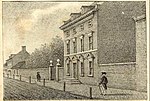5th Street/Independence Hall station
1908 establishments in PennsylvaniaRailway stations in PhiladelphiaRailway stations in the United States opened in 1908Railway stations located underground in PennsylvaniaSEPTA Market-Frankford Line stations

5th Street/Independence Hall station is a subway station in Philadelphia, Pennsylvania at the intersection of 5th and Market Street served by SEPTA's Market-Frankford Line. The station serves multiple notable Philadelphia landmarks including Independence Hall, the Liberty Bell, the National Constitution Center, the National Museum of American Jewish History, and the Philadelphia Bourse.The station originally opened as 5th Street station and was renamed by SEPTA on June 29, 2016.The station is also served by numerous SEPTA bus routes, the 17, 33, 38, 44, and 48.
Excerpt from the Wikipedia article 5th Street/Independence Hall station (License: CC BY-SA 3.0, Authors, Images).5th Street/Independence Hall station
Market Street, Philadelphia Center City
Geographical coordinates (GPS) Address Nearby Places Show on map
Geographical coordinates (GPS)
| Latitude | Longitude |
|---|---|
| N 39.9505 ° | E -75.1488 ° |
Address
5th Street
Market Street
19107 Philadelphia, Center City
Pennsylvania, United States
Open on Google Maps








